The Samsung Galaxy Note7 (S820) Review
by Joshua Ho on August 16, 2016 9:00 AM ESTFinal Words
This has been a fairly long review despite the Galaxy Note7’s similarity to the Galaxy S7 edge so it’s well worth recapping everything that has been said thus far before we get into whether the Galaxy Note7 is worth buying or not. The first and most obvious place to start is the design of this phablet. For better or worse, this looks a lot like the Galaxy S7 edge, but it’s been cleaned up in noticeable ways. The Note7 has USB-C and USB 3.1 gen 1 which improves the design with a reversible USB connector, and the design in general is much more symmetrical with things like the volume buttons, power buttons, SIM tray, USB port, 3.5mm jack, and speakers all aligned to some extent. However, things like the top microphone port and the sensors flanking the earpiece are not really symmetrical. ID detailing does matter to some extent, but given how hard Samsung was pushing this narrative of symmetrical design I really fail to see how they can miss on these small details. The design is still acceptable now, but I think by next year Samsung really needs to have a new design ready that isn’t just two slabs of 3D glass with an aluminum frame in the middle. It doesn’t need to be something completely new but it does need to be different enough that you don’t have to closely examine the phone to figure out what model it is.
Moving past design the display of the Note7 is just clearly great. It’s one of the brightest on the market and has great contrast as well as excellent color accuracy. The reduced curvature relative to the Galaxy S7 edge also significantly improves the viewing angles of the edge although the subpixel arrangement still negatively impacts viewing angles. While the display is great it’s basically the same exact display that shipped with the Note5 for better or worse with the addition of an HDR mode that I was unable to use at all. A minor bump in power efficiency or improved viewing angles would go a long way to making the Note7 more attractive, but as-is there’s nothing really wrong with it. I’m not a huge fan of the edge display as far as usability goes but if you don’t use screen protectors there’s absolutely nothing wrong with the design of the display.
Of course, if we’re talking about power efficiency it also means that we need to talk about battery life. While the Note7 delivers solid battery life, it’s definitely a step down from the great battery life of the Galaxy S7 edge due to the addition of the S-Pen. If you care a lot about battery life you’ll have to make the choice between whether the S-Pen is worth the minor drop in battery life relative to the S7 edge. The lack of updated SoCs or really anything significant here means power efficiency is identical to the Galaxy S7 lineup. Charge time remains fast, but the lack of QC 3.0 or anything more advanced makes the device get fairly warm and reduces battery lifespan.
As far as system performance goes the Note7 is pretty much a dead ringer for the Galaxy S7. It actually gets even slower in Discomark on cold runs although thankfully it improves over the Galaxy S7 for hot runs. The Galaxy Note7 performs well in benchmarks but the closer we get to real-world testing the more apparent it is that Samsung is not really doing well in real-world benchmarks which is concerning. Obviously if Samsung continues to see rising profits they’re going to completely overlook everything written here, but I wouldn’t be surprised to see people notice relative differences in performance more and more as people get used to devices like the HTC 10 and iPhone 6s which are smooth and fast in real-world usage. Performance in game-based benchmarks continues to be excellent given the Adreno 530 GPU and NAND performance is also good, although burst performance is not as high as competing SLC/TLC hybrid solutions on the market.
As far as camera goes, the Galaxy Note7 continues to ship with the fastest camera on the market. Focus latency and capture latency are really unlike anything else on the market and the Note7 rolls back some of the excessive sharpening but I’m not really a fan of the lack of fine detail on most of the camera shots produced by the Note7, nor is the lack of proper stabilization in video all that impressive. These are things that should be fixed by default and I think the drive for the thinnest module possible has significantly impacted camera quality relative to the Galaxy Note5. If you only value speed, dynamic range, and extreme low light capability then the Note7 is probably still the best camera on the market, but if image quality outside of extremely dark situations matters I would argue that HTC has done a better job with the HTC 10’s camera even with its issues with optics and lack of 1080p60 or 720p240 video modes.
The final piece worth discussing before we discuss overall value and evaluation is software. TouchWiz has been redesigned which is good and it looks a lot better than before and things like the iris scanner are actually useful and work well which is amazing considering how this is the first Android smartphone with an iris scanner. However, TouchWiz still has some strange navigation behaviors that need to be cleaned up before it’s completely free of usability issues, and things like the S-Pen Translate function are just really pointless from the time I’ve used it and don’t need the S-Pen at all to function well. Animated GIFs work well, but are not really a must-have feature. My major complaint here continues to be a general lack of performance as things like scrolling don’t feel like they have the momentum or response that they should and I still see frame drops that don’t happen in comparable devices.
With all of this said I think the Note7 is fairly checkered. I’m sure there are people that want to buy one because it’s the only phablet on the market that really does a stylus well and if you’re someone that wants the Note7 for the stylus then you should stop reading now and go buy one because everything else on the market won’t meet your needs. If the stylus is just something that’s nice for you to have then the calculus gets much more difficult and the recommendation is no longer unconditional. The Galaxy S7 edge is currently about 750 USD and you can easily find people reselling new ones for any operator or international variants on Amazon for 600 USD or so. The Note7 does appreciably improve on the Galaxy S7 Edge, but it’s basically the S7 edge in a new package and with an S-Pen. You also get an extra 32 GB of storage which does justify the extra 100 USD that bumps the Note7 up to 850 USD.
With all of that said, I get the distinct sense that it will be much harder to justify the price well before the end of this year. The camera quality is kind of a disappointment given all of the hype at the launch of the Galaxy S7 given the dual pixel sensor and larger 1.4 micron pixels when the camera quality itself is not really an improvement over the Galaxy Note5 and is beaten out by the HTC 10. The software experience still shows dropped frames. There are still software features that feel like obvious gimmicks. The design is still lacking ID detailing. I’m sure other people will praise this device anyways but when a phone is this expensive and with smartphones in general getting polished to a mirror sheen each scratch becomes more obvious no matter how minor.
A lot of things are going to seem like nitpicks but the whole point of paying 400 USD more is so that the ID and engineering in both hardware and software bridges the last mile. Again, this is still a good phone and it really is as good as it gets for now, but with so many fall launches coming up I find it very hard to whole-heartedly recommend this phone. The only audience I can really recommend this to are people that are absolutely set on a Samsung phablet, and even then if you won’t miss the S-Pen I think the S7 edge is pretty much the same experience for 100-200 USD less when the extra money gets you so little other than an extra 32GB of internal storage.
The Galaxy Note7 goes on sale August 19 on all four major carriers and at least a few preorders will be arriving within the coming days for an average price of 850 USD for the 64GB SKU in Blue Onyx, Silver Titanium, and Black Onyx.


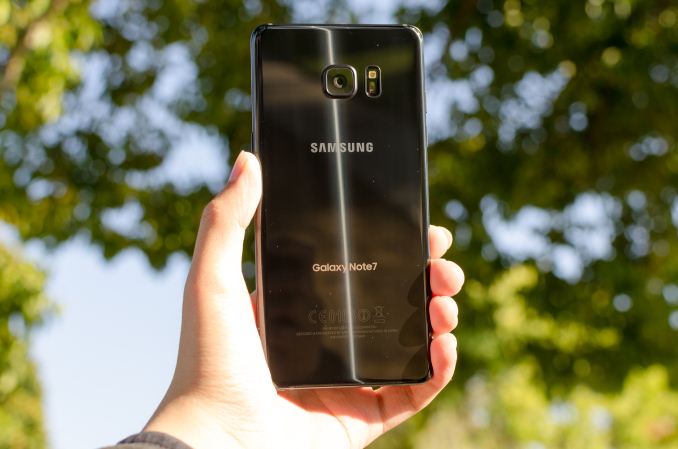
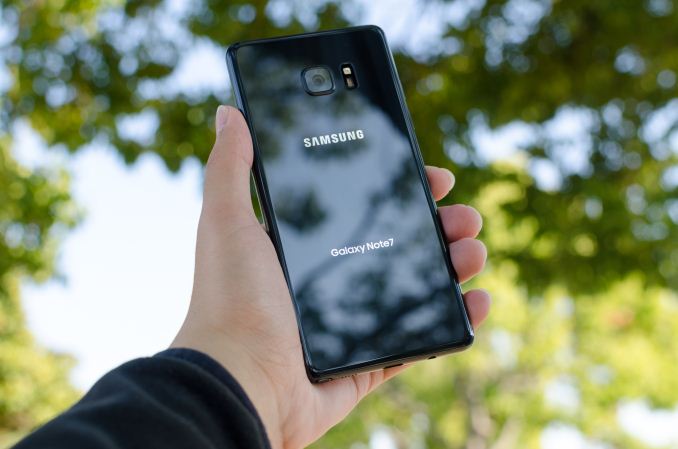

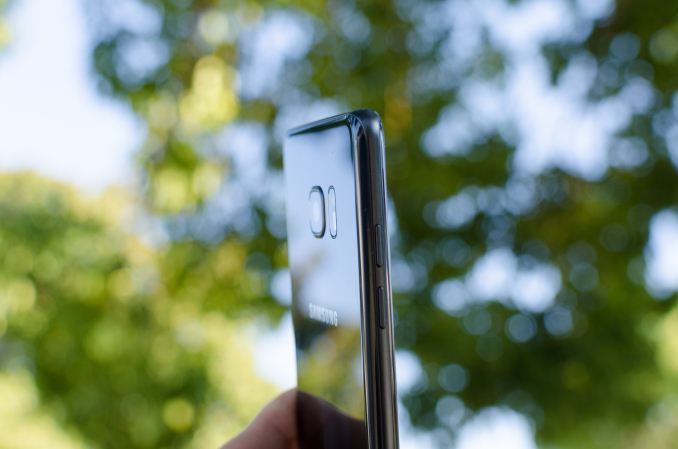
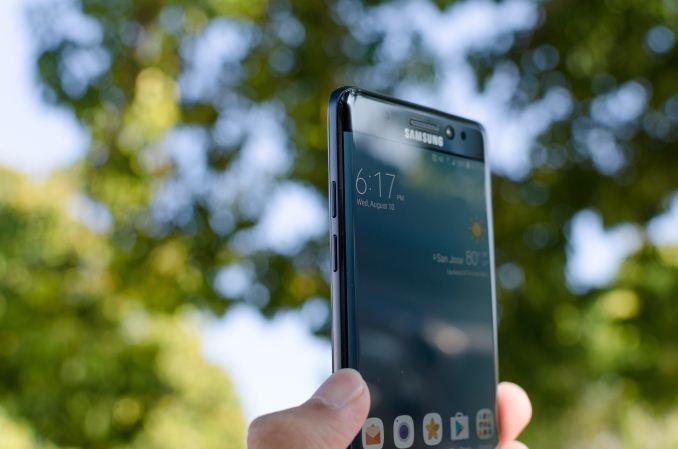
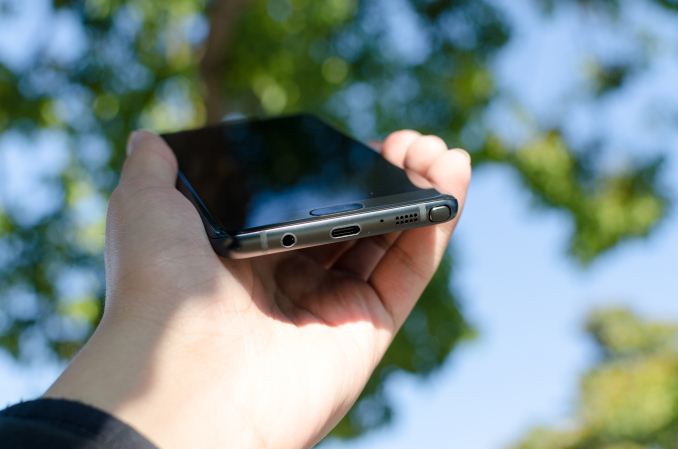
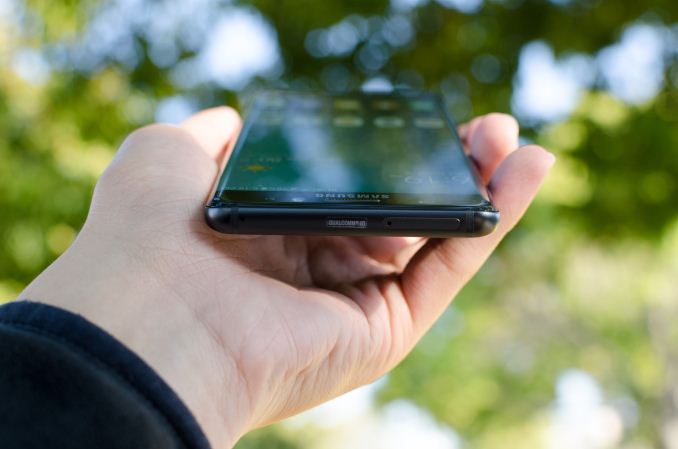
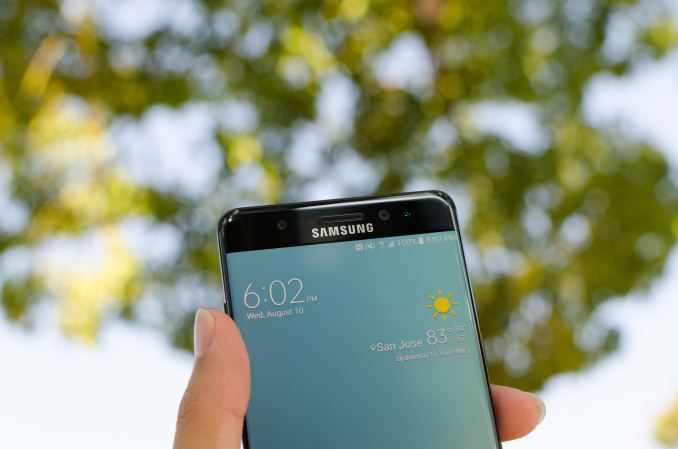








202 Comments
View All Comments
name99 - Friday, August 19, 2016 - link
For crying out loud. Read the damn comments to that article.Bottom line is it doesn't prove what you and Andrei seem to think it proves.
CloudWiz - Sunday, August 21, 2016 - link
Simply because the scheduler is able to schedule a workload across multiple threads does not mean it is taking "full advantage of 4 or more cores". Browser performance is still heavily single-threaded whether you like it or not. Read the comments on Andrei's article.I'm going by Anandtech results here, and the E7420 suffers incredibly on battery life when on LTE compared to Wifi. Without results for the E8890 I can't say for sure, but with not even Qualcomm having found a way to get LTE battery life to even EQUAL Wifi (sure they're getting close, but there's still a small delta) I severely doubt that Samsung can do it, given their E7420 difficulties. Also, personal experience is highly unreliable and unless you have some time-lapse video to prove it, I won't believe you when all the data available says otherwise.
Sure Safari is more efficient. (It's also far more performant, but that's another story.) And yes I will concede that the 6s renders at a fairly low resolution. However you must keep in mind that the 6s Plus actually renders at 2208 x 1242 which is 75% the pixels of 1440p, much closer than you would think. And render resolution on GS6/7 might not even be the display resolution - most Android apps don't bother to render at such a high resolution because most phone's don't have 1440p displays. And given screen technologies in 2016, if Apple switched to 1440p LCD I doubt there would be a 2 hour+ impact to battery life. Phones like the HTC 10 with 1440p LCD displays with the same chip as the GS7 can achieve better battery life than it with the same size battery. This is not only a testament to S820's inefficiencies but also Samsung's implementation inefficiencies. And no, the GS6/7 are not able to "keep up". I've already stated how the GS6 absolutely cannot compare with the 6s or 6s Plus, and even with the GS7 the S820 version barely edges out the 6s with a battery nearly twice the size, with even the more optimized E8890 version being unable to top the 6s Plus with a larger battery. These differences can't be attributed solely to browser inefficiencies or screen densities. Samsung's implementations are simply not efficient compared to Apple or even HTC with their S820 implementation and Huawei with their Kirin 950.
jlabelle2 - Monday, August 22, 2016 - link
- if Apple switched to 1440p LCD I doubt there would be a 2 hour+ impact to battery lifeHow do you explain then the huge drop of battery life between the MacBook from the MacBook Air?
- And no, the GS6/7 are not able to "keep up". I've already stated how the GS6 absolutely cannot compare with the 6s or 6s Plu
The iPhone 6S did not exist when the GS6 was released. The S6 had (slightly) better battery life than the iPhone 6, despite a screen bigger, with 3 times more pixels to push.
The facts do not back up your claims.
CloudWiz - Thursday, August 25, 2016 - link
You have to consider what you're comparing here. On one side you have smartphones which have screens not even 6 inches diagonally. On the other side you have full-blown computers which have screens more than twice the size diagonally. There's a reason most computers haven't moved far past the 1440p-1600p mark. The screens are so big that the power consumption gets unreasonable. The subpixels on computers have to be much larger than on a phone. A 1440p LCD on the HTC 10, for example, will not consume the same power as a 1440p Macbook screen. In fact, it consumes far less, allowing the phone to have basically the same web browsing battery life with a much smaller battery. In addition, the Macbook has a 25% smaller battery compared to the Air, further giving it the disadvantage.I stated that the 6s and 6s Plus destroy the GS6, correct? I never mentioned the 6 at all. Don't try to twist my words. The facts do indeed back up my claims and if you can't see that maybe you should take a look at those charts again. I do concede that the 6 series were terrible phones all around (terrible SoC, terrible display, terrible modem, terrible design, terrible Touch ID) but with the 6s Apple fixed almost all of these issues.
Finally, the S6 actually had worse battery life than the 6 in web browsing and in gaming (taking into account frame rates). What are you basing your (non-existent) claims off of?
sonicmerlin - Sunday, August 28, 2016 - link
You're hugely exaggerating the iPhone 6's deficiencies. Touch ID was it slow but it was far more accurate than any other fingerprint scanner implemented on a mobile device up to that point.The design was the exact same as the 6S. The modem had more LTE bands than had ever been integrated into a single device. The screen wasn't vastly different than the 6S screen either. And the SoC had great single core performance. The battery even lasted longer than the 6S.
lilmoe - Saturday, August 27, 2016 - link
Please don't be offended, but I cannot take you, or any other biased user, seriously when you're claiming that someone's argument is unreliable, then go on and prove the opposite using the same (and/or worse) approach they did. Yes, I've read the comments on that article (all of them actually), and contributed/replied to lots.-- Simply because the scheduler is able to schedule a workload across multiple threads does not mean it is taking "full advantage of 4 or more cores"
A good example of what I mean above. Your statement may (and I say: may) be correct if there WASN'T any DIRECTLY related data to prove it wrong. When 4 or more cores are ramping up (and actually computing data) during app loading and scrolling (including browsers, particularly Samsung's browser), then it sure as hell means that these apps (all the ones tested actually) ARE taking advantage of the extra cores. Unless the scheduler is "mysteriously" loading the cores with bogus compute loads, that is (enter appropriate meme here). Multi-core workloads ARE the future, Apple is sure to follow. It's taking a LONG while, but it's coming. We've also pointed out that there is LOTS of overhead in Android that needs work, and that most certain won't be remedied with larger, faster big cores. On the contrary it would be worse for efficiency.
"I'm going by Anandtech results here"
AHHHHHHH, right there is the caveat, my dear commentator. If YOU had actually read the comment section, you'd know just how much we're complaining about the inconsistency of Anandtech's charts. You never get the same phones/models, consistently, on a series of comparisons; you get the GS7 (Exynos) VS iPhone 6S+ on one, then the GS7e (S820) VS iPhone 6/6S (not the plus) on the other, considering both iPhone models are NOT the same phone, with different resolutions and different screen size/resolution (AND different process nodes among even the same models). It's relatively safe to claim, at this point, that those inconsistencies are intentional, while Anandtech's "excuse" is that not all phones are at the same "lab" at the same time. Selective results at its best. There's absolutely no effort in extracting external factors and testing HARDWARE for what it is. One could argue that the end user is getting a package as a whole, but that's also inconsistent with Anandtech's past and present testing methodology, where at times they claim that they're testing hardware, and times you get a review largely clouded by "personal opinion" like ^this one and the one before. If you really are reading the comment section, you'd see us mention that this review is personal opinion, and adds nothing to what's being said and shown online already. We can deduct the outcome, but we want to know the REASON. Anandtech fails to deliver.
Back to the argument about radios. You haven't tested the devices yourself. You haven't used any as your daily driver. I have. Anandtech's results, charts and whatnot don't only contradict my findings (and many others) in one department, but MOST. It's safe to assume that their testing methodology is flawed, seriously flawed. They absolutely do NOT take into consideration any real world usage, NOR do they completely isolate external factors to test hardware, NOR is there any sort of deep dive or tweaking to justify their claims. For WiFi, they cherry picked the least common scenario to fault the device and they didn't show any performance/reliability data for more common workloads.
I own a Galaxy S7 Edge (Exynos), since day 1. I actually go out and know lots of people, for business and leisure. My family, friends and clients own iPhones (various generations, mostly latest), Galaxies, HTCs, LGs and Huaweis. Guess who has the best reception. Guess who has better and more reliable WiFi. Guess who has the better rear camera (front camera is almost a wash now after updates, and sometimes better. It was worse at launch), BATTERY LIFE, SCREEN, features, etc, etc, etc... This isn't limited to this generation of Galaxy S/Notes, it's been this way since the S4/Note 2 (aesthetics aside). The only drawback on current generation Galaxies is reception COMPARED to previous plastic built Galaxies; they're still BETTER than the competition.
Again, what are we comparing here? Actual hardware? Or real world usage? Performance consistency? I don't know at this point. Anandtech reviews are anything but consistent, and nowhere as easy for an objective user to extract the truer result between the lines. They weren't perfect, but it was easy to deduct the facts from the claims. Now, you get a deep dive of why X is better than Y, but then you get a "statement" of why Z is better than X without anything sort of rational reasoning (sugar coated with "personal taste").
Did you read the camera review? What was Josh comparing there? If it's about post processing, then Samsung isn't worried about his "taste", what they're worried about is what MOST OF THEIR USERS like and want. Their USERS want colorful, vivid and more USABLE images, not a blurry mess. Nothing beats Samsung's camera there, especially with the new focusing system. Again, what's being compared here? Sensor quality or his own taste in post processing? If it's sensor quality, I haven't seen a side by side comparison of RAW photos using the same settings, have you??
-- Sure Safari is more efficient.
Let's stop there then, because we agree. At this point, software optimization can (and does) completely shadow any "potential" inefficiencies in radios. Everyone agrees that Chrome isn't the best optimized browser for ANY platform. Safari has built-in ad blocking, Chrome doesn't. Samsung's browser supports ad-blocking, but Anandtech didn't bother making the comparisons' more apples to apples. They claimed that it performed worse or the same as Chrome. ***BS***. Samsung's Game-Tuner enables the user to run Samsung's browser (or any other app, not just games) in 1080p and even 720p modes, but again, Anandtech didn't bother. I sure as hell noticed a SIGNIFICANT increase in render performance, battery consumption, and lower clock speeds when lowering the resolution (I run my apps and browsers in 1080p mode exclusively, and my games at 720p with no apparent visual difference, but with HUGE performance benefits).
Other than the FACT that these phones are NOT running the same software (OS, apps/games, even if they were the same "titles"), Javascript benchmarks, in particular, are an absolute mind-F***. You get VASTLY different results with different browsers on the same platform, and different results using the same browser on different platforms. Any sort of software optimization can drastically change the results more so than any difference in IPC or clock speed. Any reviewer (or computer scientists for the matter) worth their weight would never, NEVER, claim that a freagin' CPU is faster based on browser benchmarks UNLESS those CPUs were running the SAME VERSION browser, on the SAME platform, using the SAME settings, AND the SAME OS. Anandtech, among others, are "mysteriously" refusing to bring this point to light, and instead chose to fool the minds of their audiences with deliberate false assumptions. Most commentators know this, so how do you expect me, and others, to take you seriously. With that said, javascript (at this piont) is the least deciding factor of browser performance (especially on mobile).
-- This is not only a testament to S820's inefficiencies but also Samsung's implementation inefficiencies
How so? Where's the log data to back this up? Where's the deep dive? Where, in Samsung's software, is the reason for that? How can it be fixed?
This community is infested with false claims, inconsistent results, and bad methods of testing. Youtube is littered with "speedtests" and "RAM management" tests that have no evident value in everyday user experience, and FAIL to exclude external factors like router-scheduling and Google Play Services. No one runs and shuffles 10s of apps and 5 games at the same time.
I'm a regular commentator here, and I've bashed Samsung more than praising them on various subjects. I'm the first to point out the shortcomings of their tradeoffs. But I also know that these shortcomings are far, FAR less user-intrusive for the majority of consumers.
lilmoe - Tuesday, August 16, 2016 - link
"The GT7600 was only beaten in GFXBench this year by the Adreno 530 and surpasses both Adreno 530 and the T880MP12 in Basemark (it also has equal performance to the T880 in Manhattan). You make it sound like the GT7600 is multiple generations behind while it is not. It absolutely crushes the Adreno 430 and the T760MP8 in the Exynos 7420. The GX6450 in the A8 was underpowered but the GT7600 is not."You mean better drivers, right? You mean better a optimized benchmark for a particular GPU on a particular platform, VS a the "same" benchmark not optimized for any particular GPU on another platform...
Even with that handicap, the GS6/7 still manage longer battery life playing games. Amazing right?
CloudWiz - Sunday, August 21, 2016 - link
Whether or not a phone has "better drivers" or an "optimized benchmark" doesn't matter. Sure I can let Basemark go if you so wish, but GFXBench is cross-platform and not optimized (so far as I know) for either iOS or Android. The fact is that offscreen performance is very similar between all devices, and that your statement about the GT7600 'long being surpassed' is false. It's been half a generation since it's been surpassed, and I have no doubts that whatever goes in the A10 will again reclaim the GPU performance crown for Apple. And then Qualcomm/Samsung will pass it again next year - that's how technology works. But the fact that GT7600 is so close to Adreno 530 and T880MP12 despite being half a year older and on an inferior process is a testament to Apple and PowerVR. You couldn't say the same for GX6450 or even G6430.Also, have fun playing a game for 4 hours at 10 fps when it'd be far more enjoyable to play it for 2 hours at 30+ fps.
lilmoe - Saturday, August 27, 2016 - link
What are we comparing here? Unused performance or efficiency as whole? What matters in gaming desktops isn't the same for mobile devices (Smartphones). Some benchmarks are comparing Metal to OpenGL ES 3.1 when they should be comparing a lower level API to its competitor, ie: Vulcan.Mali GPUs have far surpassed PowerVR in efficiency, for a while. You can actually measure that in both benchmarks (battery portions) and real life gaming.
-- Also, have fun playing a game for 4 hours at 10 fps when it'd be far more enjoyable to play it for 2 hours at 30+ fps.
Part of the reason why I can't take you seriously (again, no offense). What game exactly runs at 10fps even at full resolution? I haven't seen any. But it's also good that you do acknowledge that Apple's implementation isn't exactly the most power efficient.
That being said, I run all my games at 720p (just like the iPhone) using Samsung's game tuner app, and not only do they run faster now, but the battery life (which was class leading at full res) is even better. Complaining that Samsung has larger batteries is like complaining that Apple has larger/wider cores. Because, again, what are we comparing here? Hardware? Or user experience??? It's not clear at this point, but the GS7 wins on both accounts at this particular workload.
Game-tuner (and the latest resolution controls in the Note7) has completely diminished my concerns with the resolution race. It doesn't matter to me anymore. They can go 4K (or complete waco 8K) for all I care, as long as I can lower the resolution. I'm baffled how there isn't a complete section about this app/feature (and Samsung's underlying software to enable it). I also bring this up because you get a benchmark tuned-down to 1080p (on my GS7 at least) results more FPS than the 1080p "offscreen" test for "some" reason. After seeing this, I'm even more conservative about these benchmarks.....
jlabelle2 - Monday, August 22, 2016 - link
- the modem on the S6 makes it last a ridiculously short amount of time on LTE and even on Wifi the 6s lasts half an hour longerDo you realize when you wrote that, that the iPhone has a ... Qualcomm modem ?
There is nothing magic about iPhone hardware that people try to make you believe.
It is crazy when you realize that the Note 7, with a bigger screen, with 50% more pixels, can still browse on LTE longer than the iPhone 6S Plus, while being significantly smaller.